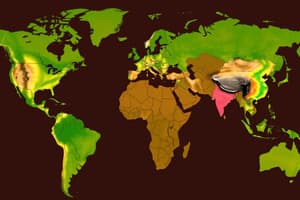Podcast
Questions and Answers
What are the three main characteristics used to classify biomes?
What are the three main characteristics used to classify biomes?
Climate, vegetation, and geography.
Which of the following is not a way humans have impacted the tundra?
Which of the following is not a way humans have impacted the tundra?
- Logging (correct)
- Mining
- Oil drilling
- Overgrazing
How was the Carboniferous period different from the Devonian period?
How was the Carboniferous period different from the Devonian period?
- Forests and land plants evolved during the Carboniferous period.
- There were vertebrates in the Carboniferous period, but not in the Devonian period.
- There were vertebrates with four legs in the Devonian period, but not in the Carboniferous.
- There was an increased number of land-based organisms in the Carboniferous period. (correct)
Which of the following is not a way humans have impacted the rainforests?
Which of the following is not a way humans have impacted the rainforests?
Which human activity has impacted both the tundra and the rainforest?
Which human activity has impacted both the tundra and the rainforest?
During which period did mammals first appear?
During which period did mammals first appear?
Which of the following is not a way humans have impacted coral reefs?
Which of the following is not a way humans have impacted coral reefs?
The classification of biomes into arid, semiarid, and temperate is based on which of the following characteristics?
The classification of biomes into arid, semiarid, and temperate is based on which of the following characteristics?
Which human activity has impacted rainforests?
Which human activity has impacted rainforests?
How does agriculture affect coral reefs?
How does agriculture affect coral reefs?
Which of the following is considered an arid biome?
Which of the following is considered an arid biome?
Flashcards are hidden until you start studying
Study Notes
Characteristics of Biomes: Overview
- Biomes are classified based on climate, vegetation, and geography.
- Ten primary biomes include desert, chaparral, alpine, taiga, tundra, savanna, deciduous forest, rainforest, freshwater, and marine biomes.
- Changes in biomes can be natural (e.g., volcanic activity) or artificial (e.g., human activity).
- Paleobotanists study ancient fossilized vegetation to understand biome evolution over time.
Historical Perspective on Biomes
- Cambrian Period featured simpler life forms like algae and trilobites in a temperate global climate.
- Devonian Period saw the emergence of forests and vertebrates, marking significant biological evolution.
- Carboniferous Period was characterized by the formation of Pangea, the evolution of four-legged vertebrates, and a rise in land-based organisms.
- During the Triassic Period, significant geological changes occurred with Pangea's separation and the development of arid environments alongside diverse flora.
Impact of Human Activity on Biomes
- Human actions have drastically altered biomes, particularly in sensitive areas:
- Tundra: Affected by mining, oil drilling, and traffic, leading to erosion, radioactive pollution, and changes in animal patterns.
- Coral Reefs: Contaminated by sewage and fertilizers, leading to algal blooms that compete with corals, along with threats from overfishing and tourism damaging ecosystems.
- Rainforests: Logged for timber and cleared for agriculture, resulting in poor soil conditions and polluted rivers.
Current Epochs and Human Influence
- The Pleistocene epoch marks the arrival of humans with significant ecological impacts.
- The Quaternary epoch is characterized as the modern era we currently inhabit.
- Alternative energy sources like wind, solar, and biomass are being developed to mitigate environmental damage.
Important Terminology and Concepts
- Paleobotany: Study of ancient plants and their evolution through fossils.
- Jurassic Period: Known for dinosaurs and the emergence of large vertebrates and flowering plants.
- Cretaceous Period: Marked by the extinction of dinosaurs and the full breakup of Pangea.
- Unique Events:
- Mammals first appeared during the Jurassic Period.
- Significant shifts in Earth’s structure and biomes have led to both evolution and extinction of various species.
Quiz Preparation: Key Questions
- Human activities impacting tundra: oil drilling, mining, but not logging.
- Distinctions between the Carboniferous and Devonian periods include an increase in land organisms during the former.
- Activities affecting rainforests include mining, agriculture, and construction.
- Significant impacts on coral reefs stem from fertilizer runoff leading to algal growth.
Biome Classifications
- Biomes categorized into arid, semiarid, and temperate based predominantly on climate patterns.
- Deserts are recognized as arid biomes distinct from grasslands, savannas, and rainforests.
Overall Impacts
- Human development has led to significant and lasting impacts on Earth's biomes, necessitating awareness and sustainability efforts moving forward.
Studying That Suits You
Use AI to generate personalized quizzes and flashcards to suit your learning preferences.




